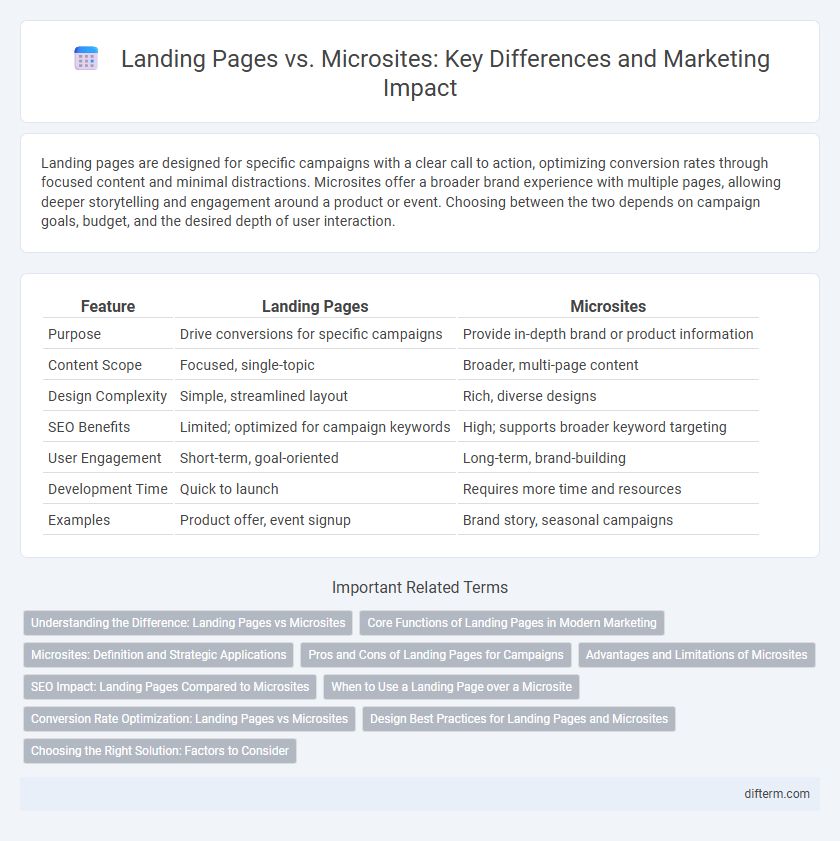Landing pages are designed for specific campaigns with a clear call to action, optimizing conversion rates through focused content and minimal distractions. Microsites offer a broader brand experience with multiple pages, allowing deeper storytelling and engagement around a product or event. Choosing between the two depends on campaign goals, budget, and the desired depth of user interaction.
Table of Comparison
| Feature | Landing Pages | Microsites |
|---|---|---|
| Purpose | Drive conversions for specific campaigns | Provide in-depth brand or product information |
| Content Scope | Focused, single-topic | Broader, multi-page content |
| Design Complexity | Simple, streamlined layout | Rich, diverse designs |
| SEO Benefits | Limited; optimized for campaign keywords | High; supports broader keyword targeting |
| User Engagement | Short-term, goal-oriented | Long-term, brand-building |
| Development Time | Quick to launch | Requires more time and resources |
| Examples | Product offer, event signup | Brand story, seasonal campaigns |
Understanding the Difference: Landing Pages vs Microsites
Landing pages are single, focused web pages designed to drive specific actions such as lead generation or product purchases, often integrated into broader marketing campaigns. Microsites are small, multi-page websites that provide detailed information around a specific campaign or brand segment, allowing for deeper storytelling and user engagement. Understanding the difference helps marketers choose between the immediacy and simplicity of landing pages and the rich content environment offered by microsites for targeted audience interaction.
Core Functions of Landing Pages in Modern Marketing
Landing pages serve as focused entry points designed to drive specific actions such as lead generation, product promotion, or event registration, optimizing conversion rates through streamlined content and clear calls-to-action. They are integral to paid advertising campaigns, email marketing, and SEO strategies, providing tailored user experiences that align with targeted keywords and audience segments. Unlike microsites, landing pages concentrate on a single objective to minimize distractions and increase user engagement, making them essential for efficient customer acquisition and campaign performance measurement.
Microsites: Definition and Strategic Applications
Microsites are small, specialized web domains or subdomains designed to focus on specific campaigns, products, or target audiences, providing a tailored user experience. They enable marketers to create highly targeted content, improve conversion rates, and enhance brand storytelling by isolating the campaign message from the main website. Strategically, microsites support product launches, seasonal promotions, or niche market engagement by delivering focused messaging and driving precise customer actions.
Pros and Cons of Landing Pages for Campaigns
Landing pages offer high conversion rates and targeted messaging, making them ideal for focused marketing campaigns with specific calls to action. They are easier and faster to create compared to microsites, reducing development costs and enabling quick adjustments based on campaign performance data. However, their limited content scope may restrict brand storytelling and SEO potential, posing challenges for long-term engagement and organic traffic growth.
Advantages and Limitations of Microsites
Microsites offer focused branding opportunities and targeted messaging, enhancing user engagement through specialized content tailored to specific campaigns or products. They provide flexibility in design and functionality, allowing marketers to test and optimize without impacting the main website's SEO or user experience. However, microsites can be costly to maintain and may dilute overall brand consistency if not carefully aligned with the primary site strategy.
SEO Impact: Landing Pages Compared to Microsites
Landing pages typically concentrate SEO efforts on a single keyword or campaign, enhancing targeted search engine rankings and improving conversion rates. Microsites offer the advantage of covering broader topics with multiple pages, generating more keyword opportunities and potential backlinks but may dilute overall domain authority. Effective SEO strategies weigh the focused relevance of landing pages against the comprehensive thematic coverage of microsites to maximize organic traffic.
When to Use a Landing Page over a Microsite
Landing pages are ideal for focused marketing campaigns targeting a single product, event, or offer, as they provide a concise, direct call-to-action that maximizes conversion rates. Use landing pages when speed, simplicity, and clear customer journey tracking are priorities, especially in PPC advertising or email marketing. Microsites are better suited for broader brand experiences, but landing pages excel in delivering targeted messages for quick lead capture and measurable results.
Conversion Rate Optimization: Landing Pages vs Microsites
Landing pages are highly focused web pages designed for specific marketing campaigns, optimizing conversion rates through targeted messaging and clear calls-to-action. Microsites offer broader brand storytelling and multiple interactive elements but may dilute conversion focus compared to landing pages. Prioritizing landing pages often results in higher conversion rates due to their streamlined, purpose-driven design in conversion rate optimization strategies.
Design Best Practices for Landing Pages and Microsites
Effective design best practices for landing pages emphasize simplicity, clear calls-to-action (CTAs), and focused content to drive user engagement and conversions. Microsites require cohesive branding, intuitive navigation, and visually appealing layouts to provide a comprehensive user experience across multiple pages. Both landing pages and microsites benefit from responsive design, fast loading times, and strategic use of multimedia elements to optimize performance and user retention.
Choosing the Right Solution: Factors to Consider
Effective marketing strategies require selecting between landing pages and microsites based on campaign complexity, target audience, and content depth. Landing pages excel in driving single, focused calls-to-action with streamlined design, ideal for lead generation and product promotions, while microsites support broader brand storytelling and multi-faceted user engagement through multiple interconnected pages. Evaluating budget constraints, SEO goals, and expected user journey complexity ensures the chosen solution maximizes conversion rates and enhances overall campaign performance.
Landing Pages vs Microsites Infographic

 difterm.com
difterm.com